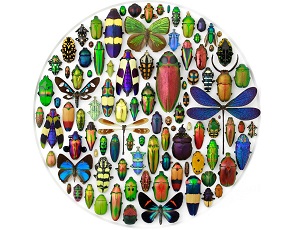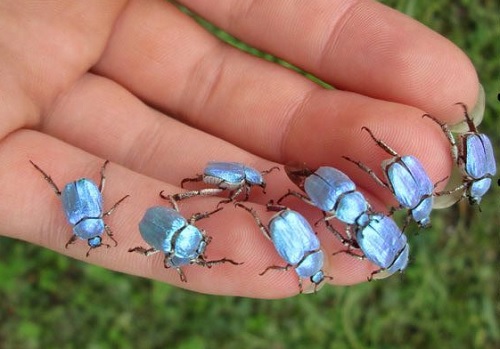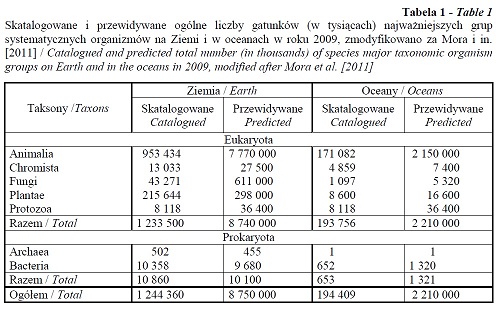
The earth is dominated by humans, whose activity contributes to the rapid decline in biodiversity on our planet. Yet, if we put members of all catalogued species together, every fourth of them would be a... beetle! What is the reason for the fact that these insects constitute such a large proportion of living beings on our globe? We asked Dr hab. Stanisław Knutelski from the Department of Entomology at the JU Institute of Biology and Biomedical Studies to shed more light on this issue.
Prof. Brett C. Ratclife from the University of Nebraska-Lilncoln (USA) is a famous coleopterist (an entomologist specialising in beetles), whose main area of expertise is the Scarabaeidae family. In his monograph devoted to the revision of the genus Gymnetis (Coleoptera: Scarabaeidae: Cetoniinae: Gymnetini) Brett C. Ratcliffe wrote that beetles constitute one fourth of living beings on earth (Ratcliffe 2018). This claim has generated both interest and confusion, and doubts have been raised about its validity. What about bacteria? Could the number of species of these omnipresent unicellular organisms without cell nuclei (Prokaryota) really be smaller than that of beetles?
 The Rattcliffe’s work, which has attracted additional attention for three newly described species named by the author after dragons from the Game of Thrones, provides the key for identification of 56 species and 4 subspecies, along with their description, diagnoses, information about geographical distribution and habitat, as well as life histories of several of them. The book also includes illustrations of all the species and some of their habitats. The described taxons include previously unknown species: Gymnetis amazona – from the Amazonian region of Brazil, Columbia and Peru; Gymnetis aurantivittae – from the Amazonian region of Brazil, Columbia, Peru and Guyana; Gymnetis drogoni – from Columbia, Ecuador, , Brazil, Argentine and Paraguay; Gymnetis merops – from Peru; Gymnetis puertoricensis – from Puerto Rico; Gymnetis rhaegali – from French Guyana; Gymnetis thula – from Texas, Louisiana and Florida, and parts of Northern Mexico, and Gymnetis viserioni – from Panama, Columbia and Ecuador. He also established neotypes (substitute specimens of a given species which replace holotypes – specimens originally used to describe the species, in case they are destroyed or lost) as well as lectotypes (specimens or illustrations of taxons designated as the name-bearing type when the author of the new species description has not established the holotype, the holotype was destroyed or lost, or it describes more than one taxon), and presented new synonyms for many species. Besides, Ratcliffe added descriptions to several taxons which had previously been nomina nuda (“naked” names which are not scientifically recognised due to the lack of an adequate description).
The Rattcliffe’s work, which has attracted additional attention for three newly described species named by the author after dragons from the Game of Thrones, provides the key for identification of 56 species and 4 subspecies, along with their description, diagnoses, information about geographical distribution and habitat, as well as life histories of several of them. The book also includes illustrations of all the species and some of their habitats. The described taxons include previously unknown species: Gymnetis amazona – from the Amazonian region of Brazil, Columbia and Peru; Gymnetis aurantivittae – from the Amazonian region of Brazil, Columbia, Peru and Guyana; Gymnetis drogoni – from Columbia, Ecuador, , Brazil, Argentine and Paraguay; Gymnetis merops – from Peru; Gymnetis puertoricensis – from Puerto Rico; Gymnetis rhaegali – from French Guyana; Gymnetis thula – from Texas, Louisiana and Florida, and parts of Northern Mexico, and Gymnetis viserioni – from Panama, Columbia and Ecuador. He also established neotypes (substitute specimens of a given species which replace holotypes – specimens originally used to describe the species, in case they are destroyed or lost) as well as lectotypes (specimens or illustrations of taxons designated as the name-bearing type when the author of the new species description has not established the holotype, the holotype was destroyed or lost, or it describes more than one taxon), and presented new synonyms for many species. Besides, Ratcliffe added descriptions to several taxons which had previously been nomina nuda (“naked” names which are not scientifically recognised due to the lack of an adequate description).
As far as Ratcliffe’s claim is concerned, according to some publications (More et al. 2011, Knutelski 2018), there are 1,244,360 known (that is, described and catalogued) species on Earth (fig. 1), whereas the recent „Catalogue of Life checklist” puts the number at 1,639,624. This figure includes 10,860 bacteria species (members of Archaea and Bacteria domains) and 386,755 beetle species (Bouchard et al. 2017). This implies that beetles constitute either 31 percent or 24 percent of all known species on our planet, which means that one in every four or one in every three species is that of a beetle. Unbelievable, but true – Professor Ratcliffe was right.
So what about the bacteria?
There are much fewer described species of bacteria (10,860) than of beetles (386,755). Yet, if we counted every single member of these groups (which, at least for now, is impossible), the number of bacteria, which are very small organisms (0.2-750 μm), would probably be the highest. But as far as the species are concerned, bacteria fall far behind beetles.
Why are there so many beetles?
J. B. S. Haldane, a British biologist and geneticists, one of the originators of population genetics, was once asked by a group of theologians what can be said about the nature of the Creator based on the studies on his creation. His answer was: “an inordinate fondness of beetles.“
Coleoptera (beetles) are the most diverse order in terms of the number of species not only among animals, but among all organisms on Earth. No other group of living beings can compete with them in terms of diversity and abundance of species.
 They live on all continents and islands, in almost all land and freshwater habitats, and even under the sea, feeding on almost every kind of organic matter, both living and dead. About three quarters of beetles are herbivores, both at the larval and adult stage, feeding on plants, wood, fungi as well as many food products, including grains, tobacco and dried fruit. The oldest known fossils of insects closely resembling beetles come from early Permian, that is, about 270 million years ago. Over time, much more species of these insects have evolved than have gone extinct (Smith and Marcot 2015), which means that they are characterised by a relatively high pace of specialisation (Farrel 1998; Hunt et al. 2007), and a very slow – almost statistically insignificant – pace of extinction, as compared to other groups of organisms (Smith and Marcot 2015). The great quantity of beetle species today results from the fact that the phylogenetically older beetles are still doing well and they are joined by the newly emergent species. The taxonomic diversity and abundance is also related to the extreme morphological, ecological and behavioural diversity of beetles and the diversification of their contemporary evolutionary lines, which are the richest in species.
They live on all continents and islands, in almost all land and freshwater habitats, and even under the sea, feeding on almost every kind of organic matter, both living and dead. About three quarters of beetles are herbivores, both at the larval and adult stage, feeding on plants, wood, fungi as well as many food products, including grains, tobacco and dried fruit. The oldest known fossils of insects closely resembling beetles come from early Permian, that is, about 270 million years ago. Over time, much more species of these insects have evolved than have gone extinct (Smith and Marcot 2015), which means that they are characterised by a relatively high pace of specialisation (Farrel 1998; Hunt et al. 2007), and a very slow – almost statistically insignificant – pace of extinction, as compared to other groups of organisms (Smith and Marcot 2015). The great quantity of beetle species today results from the fact that the phylogenetically older beetles are still doing well and they are joined by the newly emergent species. The taxonomic diversity and abundance is also related to the extreme morphological, ecological and behavioural diversity of beetles and the diversification of their contemporary evolutionary lines, which are the richest in species.
Beetles are very flexible and adaptive to changing situations and conditions. For instance, the members of Polyphaga suborder are characterised by an extremely varied diet: from algae and other plants, both dead and living, in many different forms, through living and dead animals, to their products and faeces. The ability of beetles (as well as many other groups of insects) to change from fragile, soft larvae to winged adult forms (imagines), armoured with a strong cuticle (cuticula) and the front pair of wings transformed into hard wing cases (elytra), as well as the possession of chewing mouthparts and limbs adapted to different environments indicate that these insects have been able to live in various habitats during different evolutionary stages and adapt to the changing environmental conditions on our planet.
The development of these capabilities could have been fueled by the beetles’ co-evolution with flowering plants (angiosperms) and some groups of terrestrial animals, especially mammals, as well as some geological and climatic changes, mainly in the late Cretaceous (from 145 to 65 million years ago). The emergence of flowering plants enabled beetles to enter many new ecological niches, and some of them diverged into specialised branches feeding on different parts of plants, such as roots, leaves, flowers, fruit, seeds, etc. This diversification led to an adaptive radiation. Family lines of beetles have adapted to feeding on flowering plants many times in their evolutionary history. Yet, it seems that beetles’ evolutionary success did not primarily result from their especially fast diversification, or the dominant role of their herbivorous species along with the growing specialisation of flowering plants during the Cretaceous. The pre-cretaceous origins of over 100 contemporary evolutionary lineages of these insects suggest that the abundance of beetle species mainly results from the survival of multiple lineages of these insects and their permanent diversification in different ecological niches, which occurred during the earlier geological periods.
Original text by Dr hab. Stanisław Knutelski: www.nauka.uj.edu.pl





